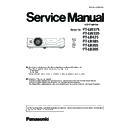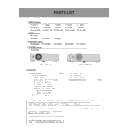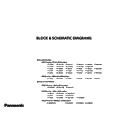Panasonic PT-LW375 / PT-LW335 / PT-LB425 / PT-LB385 / PT-LB355 / PT-LB305 (serv.man3) Service Manual ▷ View online
4
PREFACE
<LW375/LW335/LB425/LB385/LB355/LB305>
r
Cautions when setting up the projector
f
Use the adjustable foot only for adjusting the angle. Using them for other purposes may damage the projector.
f
Do not stack the projectors.
f
Do not use the projector supporting it by the top.
f
Do not block the ventilation ports (intake and exhaust) of the projector.
f
Avoid heating and cooling air from the air conditioning system directly blow to the ventilation ports (intake and exhaust) of the
projector.
f
Do not install the projector in a confined space.
When placing the projector in a confined space, a ventilation and/or air conditioning system is required. Exhaust heat may
accumulate when the ventilation is not enough, triggering the protection circuit of the projector.
Within 15°
Within 15°
Within 30°
Within 30°
r
Do not tilt the projector or place it on its side.
Do not tilt the projector body more than approximately ±30 degrees vertically or ±15 degrees horizontally. Over tilting may result
in shortening the life of the components.
For PT-LB305, keystone correction in the horizontal direction is not supported. If the projector is tilted horizontally, horizontal
trapezoidal distortion cannot be corrected.
5
PREFACE
<LW375/LW335/LB425/LB385/LB355/LB305>
For the block diagrams, schematic diagrams and parts list, refer to each separated booklet "Block and Schematic
diagrams" and "Parts List" respectively.
CONTENTS
1. Safety Precautions
2. Specifications
SECTION 1 SERVICE INFORMATION
1. Circuits Protection
2. Maintenance/Replacement
3. Notes on service
4. Troubleshooting
SECTION 2 DISASSEMBLY PROCEDURES
1. Mechanical & Electrical Parts Disassembly
2. Optical Parts Disassembly
SECTION 3 ADJUSTMENTS
1. Adjustments Items and Procedures
2. Optical Adjustment
3. Electrical adjustment
4. Firmware Update Procedure
6
PREFACE
<LW375/LW335/LB425/LB385/LB355/LB305>
1. Safety Precautions
1.1. General Guidelines
- For continued safety, no modification of any circuit must be attempted.
- Unplug the power cord from the power outlet before disassembling this projector.
- Use correctly the supplied power cord and must ground it.
- It is advisable to use an isolation transformer in the AC power line before the service.
- Be careful not to touch the rotation part (cooling fan, etc.) of this projector when you service with the upper case removed
and the power supply turned on.
- Observe the original lead dress during the service. If a short circuit is found, replace all the parts overheated or damaged
by the short circuit.
- After the service, all the protective devices such as insulation barriers, insulation papers, shields, and isolation R-C combi-
nations must be properly installed.
- After the service, check the leakage current to prevent the customer from getting an electric shock.
1.2. Leakage Current Check
1. Prepare the measuring circuit as shown in Fig.1.
Be sure to use a voltmeter having the performance described in Table 1.
2. Assemble the circuit as shown in Fig. 2. Plug the power cord in a power outlet.
3. Connect M1 to T1 according to Fig. 2 and measure the voltage.
4. Change the connection of M1 from T1 to T2 and measure the voltage again.
5. The voltmeter must read 0.375 V or lower in both of steps 3 and 4. This means that the current must be 0.75mA or less.
6. If the reading is out of the above standard, the projector must be repaired and rechecked before returning to the customer
because of a possibility of an electric shock.
M1
M2
Rs
Cs
Rb
10KΩ ±0.1%
0.022µF
±1.0%
Vb
(V) V
Rs: 1500 Ω±0.1%
Cs: 0.22 µF±1.0%
Rb: 500 Ω±0.1%
to T1
or T2
in FIg.2
Weighted leakage current=Vb / 500 (A)
Fig. 1
Isolation transformer
T1
T2
connection
to power outlet
M1
M2
Fig.2
Projector
Measuring
Circuit (Fig.1)
Performance
Voltmeter
(rms reading)
Accurancy:
≤ 2%
Input resistance:
≥ 1 MΩ
Input capacitance: ≤ 200 pF
Frequency range: 15 Hz to 1 MHz
Table 1
1.3. UV Precaution and UHM Lamp Precautions
- Be sure to unplug the power cord from the power outlet when replacing the lamp.
- Because the lamp reaches a very high temperature during its operation, wait until it cools completely when replacing the
Lamp Unit.
- The lamp emits small amounts of UV-radiation, avoid direct-eye contact with the light.
- The lamp unit has high internal pressure. If improperly handled, explosion might result.
- Because the high pressure lamp involves a risk of failure, never touch the lamp wire lead during the service.
7
PREFACE
<LW375/LW335/LB425/LB385/LB355/LB305>
2. Specifications
Power supply
100 V - 240 V
(100 V - 240 V alternating current), 50 Hz/60 Hz
Power consumption
3.5 A - 1.5 A, 300 W
In standby mode (when [Standby mode] is set to [Eco]): 0.5 W
In standby mode (when [Standby mode] is set to [Normal]): 6 W
In standby mode (when [Standby mode] is set to [Eco]): 0.5 W
In standby mode (when [Standby mode] is set to [Normal]): 6 W
LCD
panel
Panel size
PT-LW375, PT-LW335
1.5 cm (0.59") (aspect ratio 16 : 10)
PT-LB425, PT-LB385, PT-LB355,
PT-LB305
1.6 cm (0.63") (aspect ratio 4 : 3)
Display method
Translucent screen LCD panel 3 panels, 3 primary color system
Drive method
Active matrix method
Pixels
PT-LW375, PT-LW335
1 024 000 pixels (1 280 x 800 dots) x 3 panels
PT-LB425, PT-LB385, PT-LB355,
PT-LB305
786 432 pixels (1 024 x 768 dots) x 3 panels
Lens
Manual zoom
1.2 x
Manual focus
PT-LW375, PT-LB425, PT-LB385,
PT-LB355
F = 1.6 ~ 1.76, f = 19.16 mm ~ 23.02 mm
PT-LW335, PT-LB305
F = 2.1 ~ 2.25, f = 19.11 mm ~ 22.94 mm
Luminous lamp
230 W UHM lamp
Light output *
1
PT-LW375
3 600 lm
PT-LW335, PT-LB305
3 100 lm
PT-LB425
4 100 lm
PT-LB385
3 800 lm
PT-LB355
3 300 lm
Contrast ratio *
1
16 000 : 1 (When [Lamp control] is set to [ (Normal)], [Image mode] is set to [Dynamic]
and [Iris] is set to [On].)
and [Iris] is set to [On].)
Color system
7 (NTSC, NTSC4.43, PAL, PAL-N, PAL-M, SECAM, PAL60)
Projection size
0.76 m - 7.62 m (30" - 300")
Screen aspect ratio
PT-LW375, PT-LW335
16 : 10
PT-LB425, PT-LB385, PT-LB355,
PT-LB305
4 : 3
Projection scheme
[Front], [Rear], [Ceiling/Front], [Ceiling/Rear] (Menu setting system)
Built-in speaker
PT-LW375, PT-LW335, PT-LB425,
PT-LB385, PT-LB355
10 W (monaural) x 1
PT-LB305
2 W (monaural) x 1
Power cable length
1.8 m (70-7/8")
Cabinet
Molded plastic
Dimensions
Width: 335 mm (13-3/16")
Height: 96 mm (3-25/32") (when adjustable foot shortened)
Depth: 252 mm (9-29/32")
Weight
PT-LW375, PT-LW335, PT-LB425,
PT-LB385, PT-LB355
Approx. 2.9 kg (6.39 lbs.) *
2
PT-LB305
Approx. 2.8 kg (6.17 lbs.) *
2
Noise level *
1
When set to [ (Normal)] in [Lamp control] : 39 dB
When set to [ (Eco)] in [Lamp control] : 35 dB
When set to [ (Quiet)] in [Lamp control] : 30 dB
Operating
environ-
ment
Operating
environment
temperature *
3
5 °C (41 °F) to 40 °C (104 °F) (Elevation: below 1 400 m (4 593'))
5 °C (41 °F) to 35 °C (95 °F) (Elevation: 1 400 m (4 593') ~ 2 700 m (8 858'))
5 °C (41 °F) to 35 °C (95 °F) (Elevation: 1 400 m (4 593') ~ 2 700 m (8 858'))
Operating
environment
humidity
20 % to 80 % (no condensation)



